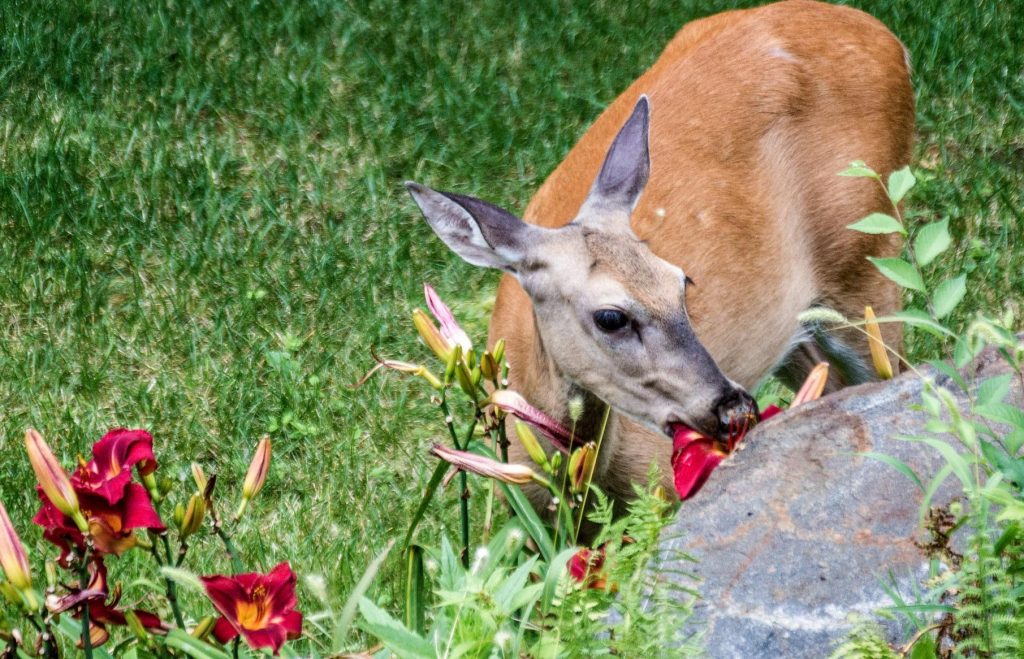

We’re here to help! Wild Yards is a completely free website that is 100% dedicated to helping you create a wildlife-friendly, sustainable yard. Read more
WildYards is reader-supported. When you buy a product through a link on our site, we may earn a comission. Every product is independently selected by our (obsessive) editors and our reviews are unbiased and objective. Read more about our mission or our privacy policy.
While many of us enjoy attracting deer to our gardens, it’s reasonable to be concerned about different plants, flowers, and vegetables you may be growing. While it’s possible to attract deer without them eating all your prized blooms, it pays to plan! For example – do deer eat impatiens?
Deer will eat impatiens – from flower to stem. These bright, colorful flowers make for tasty snacks for roving deer in and out of gardens – meaning you’ll need to be careful protecting your crop.
Why do deer like eating impatiens?
Impatiens are fairly easy for deer to eat – they aren’t fluffy, prickly, or coated in foul smells or tastes. As deer are opportunistic feeders, they will happily munch through whole flowerbeds full of impatiens, moving onto other plain-tasting, defenseless plants and vegetables in your garden.
Impatiens are not deer-resistant, though the term ‘deer-resistant’ is something of a misnomer as it stands. If hungry enough, deer will eat just about anything – even plants it dislikes. Otherwise, the familiar deer species have evolved to eat ‘unproblematic’ plants and flowers, such as the impatiens, that won’t affect their highly complex ruminator digestive systems.

Deer have learned to scavenge and swallow up soft, bland-tasting greenery such as impatiens as it won’t cause problematic blockages in its digestion. Deer will actively avoid dry, tough, thorny, or prickly vegetation because their systems may have trouble breaking it down. A deer that has difficulty digesting will, sadly, risk starvation.
Naturally, many people want to ensure local deer have lots of healthy food to eat – but when it comes to your crop of impatiens, you’d be forgiven for wanting to deter local deer from taking a closer look.
Why should I protect my impatiens from deer?
Impatiens won’t cause deer any harm to eat and digest – rather, it’s worth protecting these flowers for the fantastic benefits they bring to your garden otherwise. While your impatiens bed may be attracting lots of deer, if they get eaten up, you may find it harder to welcome certain pollinators to your yard.
Impatiens can attract hummingbirds and will appeal to butterflies (less so bees). There is disagreement over the nectar potential in the average impatiens plant, with some sources suggesting it may be an ornamental growth. Regardless, colorful impatiens will interest important garden pollinators and, if little else, will help keep your garden looking bright and pleasant.
An impatiens garden post-deer-attack, of course, will look disastrous. While impatiens aren’t difficult to grow, unless you change how you grow and protect your plants, deer will keep coming back to eat your plants. Providing they know you have a reliable selection of flowers they can feed on, local deer will remember your location.
What some gardeners may not realize is that, in some states, it is illegal to feed deer at all. This is in line with balancing local ecosystems as much as protecting people from potential attacks!
Whether you intend to feed deer – or do so accidentally by growing impatiens they can easily access – you may fall foul of the local law. Be sure to check your state legislation regardless of your position.
How can I stop deer from eating all my impatiens?
Using simple deterrents, you can humanely protect your impatiens from getting eaten by deer. Despite some anecdotal advice you may hear, you can repel deer from visiting your yard without harming them.
Plant your impatiens close to your home
Deer are fairly timid creatures, meaning any sound or sight of human activity will trigger a fight or flight response. By planting impatiens as close to your property as possible, deer will be less likely to make the trip nearer to you. This may work doubly well if you own a dog and if you can plant your impatiens within clear oversight of a window.
With this in mind, do make sure you remove and/or replant any impatiens you may have growing towards the far end of your yard, where deer are likely to enter. It’s also worth avoiding growing other plants deer love to eat, such as hydrangeas, and avoiding growing trees towards the far end of your garden.
Interestingly, some evidence suggests that growing impatiens in USDA zones where they are most hardy (particularly zones 9 through 11) may help protect them against deer attacks.
Plant uninteresting flowers and vegetables around the far end of your yard
As much as you should bring your impatiens close to your home, it’s worth considering growing plants deer dislike near to where they may make an entrance. Plants such as ferns, elephant ear plants, and even long grass may deter deer from investigating a yard. As established, no plants will completely deter deer, rather, they prefer some species more than others.
Consider letting your lawn grow a little longer than usual towards the far end of your yard. This will have the double effect of not only preventing deer from heading further up to feast on impatiens but also helping inspire visits from pollinators such as butterflies.
Do be vigilant with tall grass – as some gardeners advise that taller spines may encourage deer to bed down. This is only likely to be the case if deer know for certain that your yard is free from the threat of predators and that they can freely access food such as impatiens whenever they wish. Otherwise, deer barely eat grass unless they are extremely hungry.
Use visual or sound distractions
As deer are easily scared away from unfamiliar environments, it’s reasonable to expect sudden noises and sights will send them fleeing. You can humanely trigger a flight response by setting up motion detector lighting or random-trigger bulbs that flash at intervals. A more cost-effective option may be to hang up a string of old CDs glued to a rope, as the light will reflect and shine off their surfaces.
It’s even worth setting up a scarecrow that can blow around in the wind – or, alternatively, move the location of the scarecrow yourself a few times a week.
For sound diversions, as much as some people dislike them, wind chimes prove highly effective at keeping deer from entering gardens as well as coming back. Though, it’s recommended you attempt this solution with another idea from this list, as there’s still a chance deer will get immune to your distractions and still hunt down any available impatiens.
Upgrade your perimeter
A good way to keep deer away from both your impatiens and your garden, period, is to simply set up taller fence panels towards the edge of your yard. Believe it or not, some deer can leap higher than eight feet in the air, and if they know what to expect on the other side of your fence, they will happily leap to and fro in the future.
If you don’t wish to set up a fence that’s much taller than this, or would prefer to take a different approach, consider setting up deer netting instead.
Use repellents
While not the first nor best option for deterring deer from your impatiens, many gardeners report positive results from spraying deer deterrent solutions around their most vulnerable plots. You can buy natural repellents online and in stores – such as those made with urine scent – or, some gardeners also suggest mixing a solution of egg whites and water together to stop deer from visiting. This, reportedly, may also work with hot sauce (though you’ll need to dilute it heavily to at least 16 parts of water).
Are my impatiens at risk from other animals?
Impatiens can attract various unwanted visitors – such as small mammals, rodents, and insects.
Depending on where you are in the US, you may find that wild rabbits show interest in your impatiens – opossums, too, can easily make their way through small gaps to eat plants they can rely on growing in your garden throughout the spring and summer.
To protect your impatiens from hungry mammals, follow the advice above and cover your patch with netting.
To protect your impatiens from insects, it’s best to research a natural repellent that won’t hurt your plants. Do keep in mind, of course, that many insects perceived to be invasive, or pests, are part of the wider ecosystem in your garden. Avoid using chemicals or sprays that kill insects in this regard, and instead focus on deterring them – you may even wish to attract hummingbirds to your garden so you have a form of natural pest defense in place.
Can I still attract deer to my garden and grow impatiens?
You can grow impatiens and still attract deer to your yard, but it will take some careful planning.
As above, if you wish to keep welcoming deer, be sure to portion off your yard so that deer will only visit specific areas. Considering growing plants deer love and leaving out vegetables for your visitors towards the far end of your garden, growing plants they avoid further up your yard and in among your impatiens.
Deer won’t think twice about feasting on your colorful impatiens, so be sure to protect them humanely – mix them up with less attractive plants, set up distractions, and set up a firm border if you prefer.
